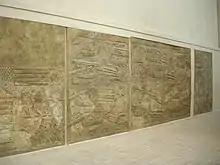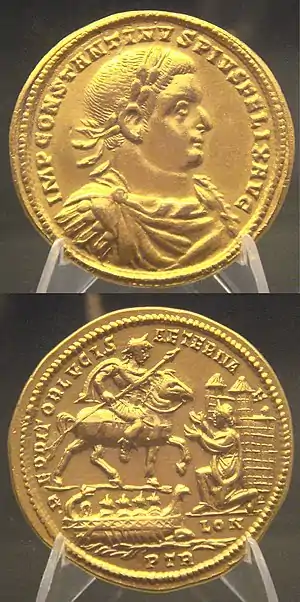
The reliefs at the Louvre
The Assyrian Timber Transportation relief is a well-known wall relief from the palace of Dur-Sharrukin, the Assyrian capital under Sargon II. The reliefs are held in the Louvre, having been excavated in 1844 by Paul-Émile Botta.[1]
Gallery
 The depictions of horse-headed boats have been compared to those on the Balawat Gates
The depictions of horse-headed boats have been compared to those on the Balawat Gates.jpg.webp) ...as well as to the Neumagen ship at the Rheinisches Landesmuseum Trier
...as well as to the Neumagen ship at the Rheinisches Landesmuseum Trier ...this ship on the Nile mosaic of Palestrina...
...this ship on the Nile mosaic of Palestrina... ...and the Arras Medallion from the Beaurains Treasure
...and the Arras Medallion from the Beaurains Treasure_plate_32.jpg.webp) Botta illustration 1849
Botta illustration 1849_overview.jpg.webp) Botta overview
Botta overview_plate_35.jpg.webp) Botta illustration 1849
Botta illustration 1849_plate_33.jpg.webp) Botta illustration 1849
Botta illustration 1849_plate_34.jpg.webp) Botta illustration 1849
Botta illustration 1849
Notes
References
- ALBENDA P., "A Mediterranean Seascape from Khorsabad", Assur 3/3, 1983, p. 1-17.
- FONTAN E., "La Frise du Transport du Bois, Décor du Palais de Sargon II à Khorsabad", DOUMET-SERHAL Cl. (ed.), Cedrus Libani, Archaeology and History in Lebanon , 2001, vol.14, p. 58-63.
- Linder, E. (1986). The Khorsabad Wall Relief: A Mediterranean Seascape or River Transport of Timbers? Journal of the American Oriental Society, 106(2), 273-281. doi:10.2307/601591
This article is issued from Wikipedia. The text is licensed under Creative Commons - Attribution - Sharealike. Additional terms may apply for the media files.